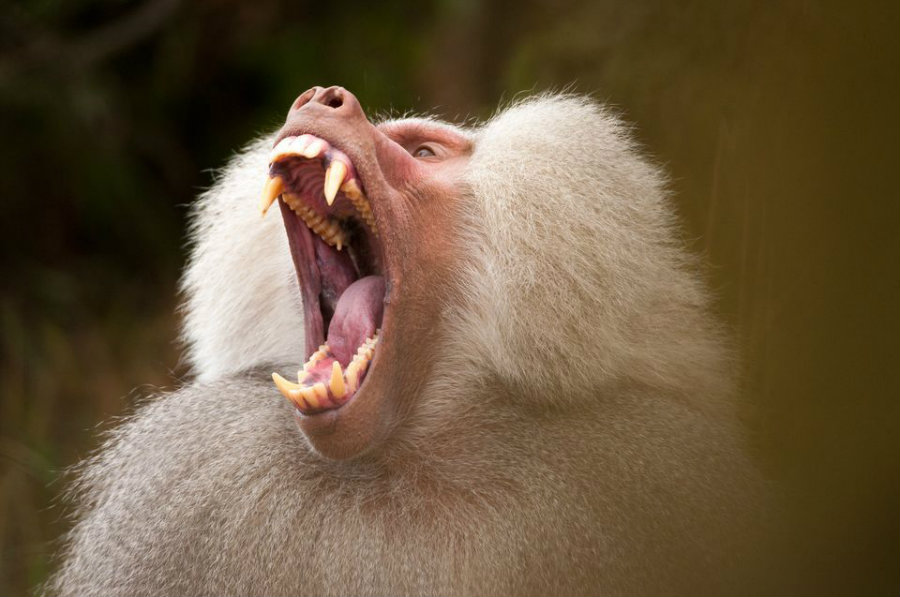French scientists say that baboons can make vowel-like sounds similar to humans. They believe that the origins of human language may go back to 25 million years, even before the appearance of our own race.
The authors of the research studied the acoustics of 1,335 Guinean baboon sounds and the animals’ tongue anatomy. They say that this new study falsified the belief that our language developed after the appearance of humanoids with a low larynx because the ability to speak was already present in ancestors such as baboons.

“The evidence developed in this study does not support the hypothesis of the recent, sudden, and simultaneous appearance of language and speech in modern Homo sapiens,” the study says. “It suggests that spoken languages evolved from ancient articulatory skills already present in our last common ancestor … about 25 million years ago.”
The origins of human speech have always been a mystery to scientists
Many scientists have thought that humans’ ability to speak evolved recently, within the last 100,00 years, due to our primate ancestors didn’t develop vocal tracts, which are physically needed to generate speech. However, new research is out to prove this assumption is mistaken. Apparently the ability to vocalize vowel-like sounds, which is necessary to speak, was also shared with one of our ancestors, the baboon.
It is important to acknowledge that human speech is largely possible thanks to the use of vowels. Humans are able to make more significant chunks of sound by placing them between consonants. Sadly, it is hard to track the origins of our speech because, unlike bones or shells, words leave no fossil imprint scientists can study.
“Language is a key difference between humans and the rest of the natural world, but the origin of our speech remains one of the greatest mysteries of science,” scientists wrote.
Researchers studied 15 guinea baboons living in an outdoor enclosure at the National Center for Scientific Research’s primate center in Rousset-sur-Arc, France. Twelve of them were female, and the remaining three were male baboons. The authors say that they found a loose parallel between human vowels and baboon vocalizations.

They recorded the sounds made by baboons to test the idea and look for formants, which are the concentration of acoustic energy around key frequencies in human speech. The individual formants found in one vowel can tell the configuration of the mouth that made the sound. It can tell how high the tongue was, if it was pushed forward or if the lips were rounded, and basically determine the shape of the vocal track that vocalizes each sound.
Scientists analyzed five types of baboons’ vocalizations: grunts, wahoos, barks, yaks and mating calls. They recorded 1,335 natural vocalizations, and after they split the wahoos into their ‘wa’ and ‘hoo’ subunits, they found 1404 vowel-like sounds.
Researchers recorded all day, focusing on the half-hour before feeding and excluding dinner time because the baboons were busy eating. The study was published Wednesday in the journal PLoS One.
Humans and baboons have similar muscles in their tongues
Scientists also verified that baboons were physically capable of making sounds. To do so, they dissected and analyzed the tongues of two baboons, which died from natural causes. They found similar muscles in baboon and human tongues, which could explain their ability to make those sounds. Before this research, it was believed that speech was not possible before the appearance of humanoids with a low larynx. But now it seems that tongue position is more important than the larynx’s height.
“We believe that the currently dominant view, that vowel systems can only have emerged after the descent of the larynx in modern Homo sapiens, is falsified by our finding of 5 distinct vowel qualities in a 2-dimensional system in an old world monkey, the Guinea baboon,” the authors wrote.
Though speech involves a neurocognitive mechanism, it also engages anatomical traits that might leave fossil clues as well as physiological and behavioral aspects that can compare with living primates. Now, primates have developed much higher larynxes and can make sounds that are similar as those produced by humans. This belief diverted scientists’ interest away from the sounds made by non-human primates.
This study challenges the assumption made about lower larynxes, mainly because other animals who have them don’t produce vowel-like sounds. Also because human babies, who at first have very high larynxes, can still make sounds as adult humans can.
Professor Scott Moisik of the Max Planck Institute for Psycholinguistics in the Netherlands said that though he wasn’t involved in the study, the outcome fits with those of other research. He also said that vowels are just a part of the equation and that it would be great to continue the research focusing in consonants instead.
Source: The New York Times
